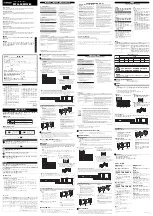
8
7. Battery information
•
Keep all batteries out of the reach of children.
•
Do not leave batteries lying around, as they present a choking hazard for children and pets. Seek
immediate medical advice if a battery is swallowed.
• Do not short-circuit or dissemble batteries or rechargeable batteries. Do not throw them into fire. This
may cause an explosion!
•
When handling leaking or damaged batteries, always use suitable protective gloves to avoid burning
your skin.
• Do not attempt to recharge disposable, non-rechargeable batteries. This may cause a fire or explosion!
Only recharge compatible rechargeable batteries and ensure that you use a suitable battery charger.
•
Please observe correct polarity (plus/+ and minus/-) when inserting the batteries/rechargeable batteries.
•
If the device is not used for a longer period of time (e.g. storage), remove the batteries/rechargeable
batteries from the remote control and from the car to avoid damage from leaking batteries/rechargeable
batteries.
•
Rechargeable batteries should be charged at least once every 3 months to prevent damage due to deep
discharge.
•
Always replace the entire set of batteries or rechargeable batteries. Do not mix full batteries or
rechargeable batteries with half-full ones. Always use batteries or rechargeable batteries of the same
type and from the same manufacturer.
•
Never mix disposable batteries with rechargeable batteries.
•
Because rechargeable batteries have a lower output voltage (1.2 V) than disposable batteries (1.5 V),
we recommend that you use only batteries (not rechargeable batteries) in the remote control transmitter
for operational safety reasons. Otherwise, the transmitter's voltage will become too low in a relatively
short amount of time.
•
Alternatively, a two-cell LiPo rechargeable battery with a BEC connector can be used in the transmitter
(rated voltage 7.4 V).









































